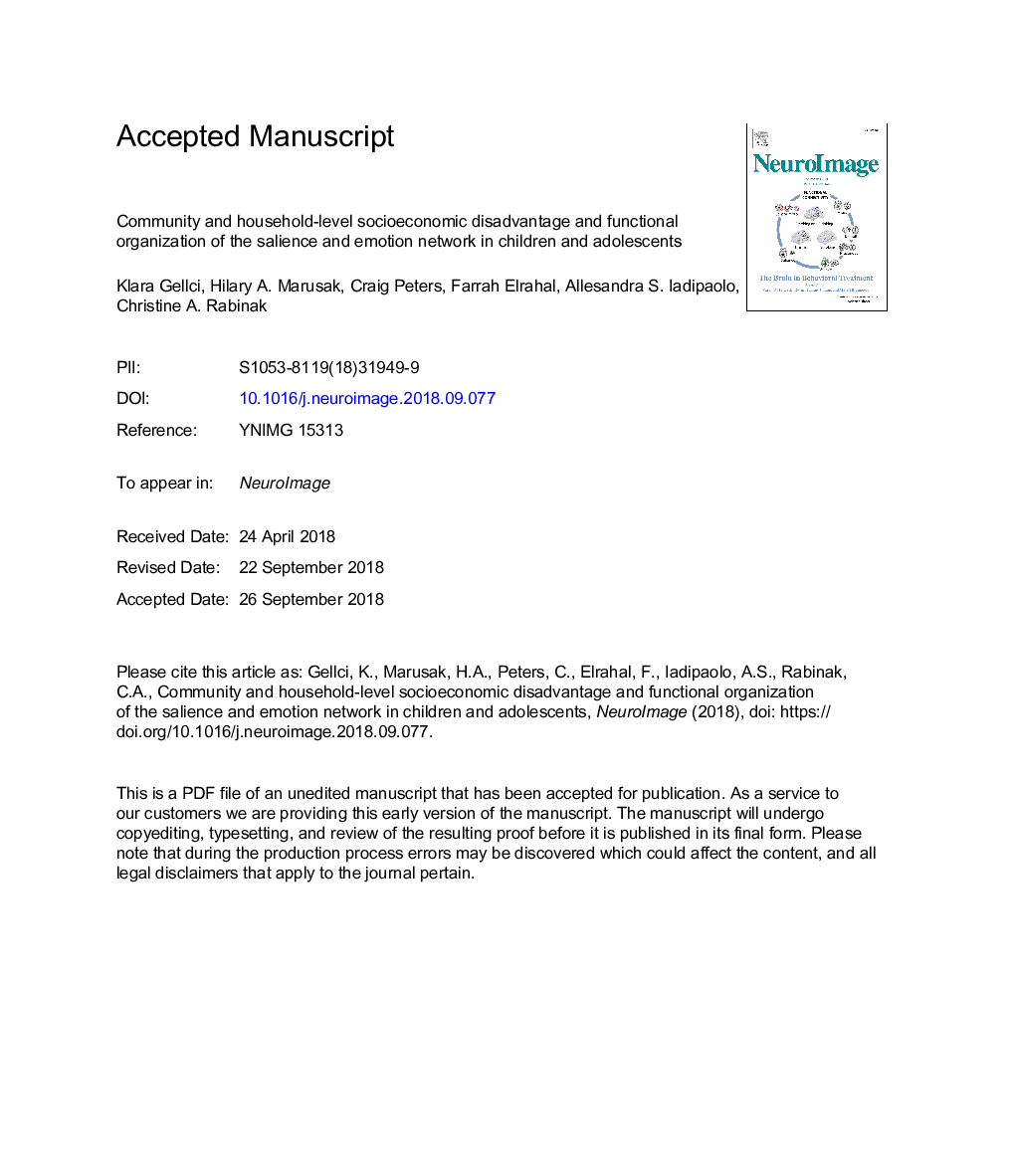| کد مقاله | کد نشریه | سال انتشار | مقاله انگلیسی | نسخه تمام متن |
|---|---|---|---|---|
| 11025528 | 1678892 | 2019 | 42 صفحه PDF | دانلود رایگان |
عنوان انگلیسی مقاله ISI
Community and household-level socioeconomic disadvantage and functional organization of the salience and emotion network in children and adolescents
ترجمه فارسی عنوان
کمبود اجتماعی و اقتصادی در سطح خانواده و سازماندهی عملکرد شبکه مهم و عاطفی در کودکان و نوجوانان
دانلود مقاله + سفارش ترجمه
دانلود مقاله ISI انگلیسی
رایگان برای ایرانیان
کلمات کلیدی
وضعیت اجتماعی و اقتصادی، شبکه قابل توجه نظریه گراف، حالت استراحت، اتصال به عملکرد درآمد،
موضوعات مرتبط
علوم زیستی و بیوفناوری
علم عصب شناسی
علوم اعصاب شناختی
چکیده انگلیسی
Socioeconomic disadvantage (SED) during childhood has been linked to disparities in physical and mental health. A growing body of research has focused on identifying neurodevelopmental consequences of SED, commonly measured using within-household factors (e.g., household income), to better understand the processes underlying SED-related disparities. These studies suggest that childhood SED has a widespread impact on brain development, altering development of multiple brain regions simultaneously. These findings also raise the possibility that childhood SED impacts development of key brain systems, such as the salience and emotion network (SEN), which is positioned at the intersection of brain systems involved in cognitive and emotion-related functioning and is thought to mediate information flow within and between these networks. The present study tests for associations between household- and community-level SED, as well as their interaction, and measures of SEN-based functional neural organization in 57 children and adolescents (ages 6-17). We applied graph theoretical analyses to resting-state functional magnetic resonance imaging (fMRI) data to examine SEN-based functional network topology. Results showed that youth residing in more distressed communities demonstrate lower hub-like properties (i.e., less efficient global information transfer and fewer connections) of two core SEN nodes - the anterior cingulate cortex and the left supramarginal gyrus. Similarly, lower household income was associated with lower efficiency of the anterior cingulate, but had no effect on the supramarginal gyrus. There was, however, an interaction between income and community SED in the rostral prefrontal cortex, such that higher income was associated with higher clustering coefficient and lower betweenness centrality, suggesting greater local processing and lower influence of this region on information flow across the network. These effects were significant only among youth living in low (but not high) SED communities, suggesting that within-household SED factors may not protect against the detrimental effects of a disadvantaged community context. Similarly, the age-related increase in average path length of the left rostral prefrontal cortex was only significant among youth living in low (but not high) SED communities. Given that maturation of the SEN is considered to be a critical functional backbone supporting the development of more flexible cognitive and emotional processes into adulthood, we tested for links between SEN graph metrics and measures of cognitive and emotion-related functioning. We found that higher community SED and lower income were both associated with lower IQ. Lower IQ, in turn, was associated with global efficiency of the left supramarginal gyrus. Observed effects of SED on SEN-based functional neural organization may help to explain the strong and pervasive link between childhood SED and disparities in cognitive and emotional outcomes.
ناشر
Database: Elsevier - ScienceDirect (ساینس دایرکت)
Journal: NeuroImage - Volume 184, 1 January 2019, Pages 729-740
Journal: NeuroImage - Volume 184, 1 January 2019, Pages 729-740
نویسندگان
Klara Gellci, Hilary A. Marusak, Craig Peters, Farrah Elrahal, Allesandra S. Iadipaolo, Christine A. Rabinak,
